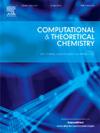Synthesis and characterization of the Na2CdEDTA complex, and density functional theory (DFT) study of EDTA species
IF 3
3区 化学
Q3 CHEMISTRY, PHYSICAL
引用次数: 0
Abstract
Cadmium, a toxic environmental contaminant, accumulates in the food chain, causing oxidative stress and health risks, necessitating detection methods. Our study employs Density Functional Theory (DFT) to investigate the electronic structure and reactivity of EDTA microspecies, focusing on their highest occupied molecular orbitals (HOMO) and lowest unoccupied molecular orbitals (LUMO) using ORCA 5.0 and the B3LYP functional. Geometric optimizations utilized the def2-SVP basis set, and the calculations incorporated advanced convergence techniques to ensure accuracy. The results revealed ten distinct EDTA microspecies, each exhibiting unique electronic properties. Notably, the -4YO microspecies predominates at pH levels of 7 or higher, characterized by a high HOMO energy and significant electron delocalization. Reactivity assessments demonstrated varying stability and chemical behavior across the microspecies, with the -4YO showing a propensity for rapid reactions due to electrostatic repulsion among negative charges. The study also synthesized the Na2CdEDTA complex, characterized by UV–Vis, FT-IR, and XRD techniques. XRD confirmed a distinct crystalline structure, while FT-IR and UV–Vis analyses indicated coordination between Cd2+ ions and EDTA's carboxyl groups. The findings emphasize the significant influence of pH on EDTA's chelating efficiency, highlighting its potential in applications like water purification and medical treatment. This work provides a comprehensive understanding of EDTA's electronic structure, reactivity, and complexation behavior with metal ions.

Na2CdEDTA配合物的合成、表征及EDTA物种密度泛函理论(DFT)研究
镉是一种有毒的环境污染物,会在食物链中积累,造成氧化应激和健康风险,因此需要检测方法。我们的研究采用密度泛函理论(DFT)来研究 EDTA 微物种的电子结构和反应性,并使用 ORCA 5.0 和 B3LYP 函数重点研究了它们的最高占位分子轨道(HOMO)和最低未占位分子轨道(LUMO)。几何优化使用了 def2-SVP 基集,计算采用了先进的收敛技术以确保准确性。计算结果揭示了十种不同的 EDTA 微物种,每种微物种都表现出独特的电子特性。值得注意的是,-4YO 微物种在 pH 值为 7 或更高时占主导地位,具有高 HOMO 能量和显著的电子分散性。反应性评估表明,不同微种具有不同的稳定性和化学特性,其中 -4YO 微种由于负电荷之间的静电排斥作用,具有快速反应的倾向。研究还合成了 Na2CdEDTA 复合物,并通过紫外可见光、傅立叶变换红外光谱和 X 射线衍射技术对其进行了表征。X 射线衍射证实了其独特的晶体结构,而傅立叶变换红外光谱和紫外可见光分析表明了 Cd2+ 离子与 EDTA 羧基之间的配位。研究结果强调了 pH 值对 EDTA 螯合效率的重要影响,凸显了 EDTA 在水净化和医疗等领域的应用潜力。这项研究全面了解了 EDTA 的电子结构、反应活性以及与金属离子的络合行为。
本文章由计算机程序翻译,如有差异,请以英文原文为准。
求助全文
约1分钟内获得全文
求助全文
来源期刊

Computational and Theoretical Chemistry
CHEMISTRY, PHYSICAL-
CiteScore
4.20
自引率
10.70%
发文量
331
审稿时长
31 days
期刊介绍:
Computational and Theoretical Chemistry publishes high quality, original reports of significance in computational and theoretical chemistry including those that deal with problems of structure, properties, energetics, weak interactions, reaction mechanisms, catalysis, and reaction rates involving atoms, molecules, clusters, surfaces, and bulk matter.
 求助内容:
求助内容: 应助结果提醒方式:
应助结果提醒方式:


